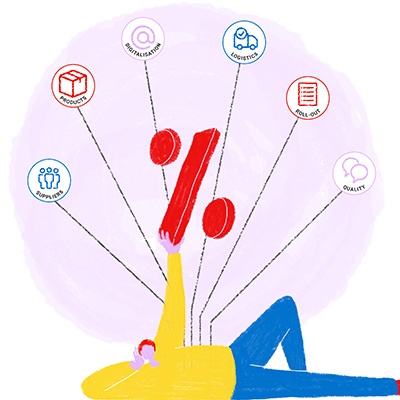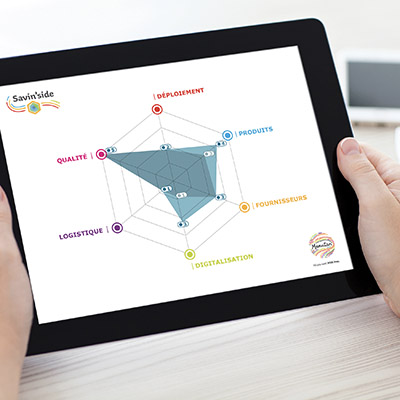More than a year and a half after the health crisis, the time has come for economic recovery. After the shutdown or slowdown of the vast majority of business sectors, companies are now poised for recovery. While purchasing has played a key role in this critical period, the challenge is to maintain this strategic positioning to support companies through the economic recovery. A study commissioned by Ivalua and conducted by Forrester Consulting, entitled “Procurement Plays a Key Role in Restoring Growth[1]”, has provided some interesting insights on this issue. More than 400 decision makers in purchasing were asked about their new priorities in the wake of the Covid-19 pandemic.
Purchasing at the Heart of the Crisis
At the start of the health crisis, the purchasing was in the midst of the turmoil. Purchasing departments have had to simultaneously secure the necessary stocks of personal protective equipment to protect employees, ensure the smooth running of production and identify supply chain risks to keep businesses operating, as far as possible.
Laurent Tardif, Chairman and CEO of Prysmian Group Southern Europe, spoke about this during a round table of experts: “The crisis that we experienced has further highlighted the key role of purchasing, which was naturally involved in all our Covid meetings and committees.” In the face of adversity, purchasing has earned its credentials. It has at last been universally recognised as a strategic department within the company. Now that the emergency is over, companies are moving into a phase of reconstruction, action and recovery!
New Priorities for Purchasing
As the global economy gradually recovers from the health crisis, purchasing departments are having to redefine their priorities. While innovation and sustainable purchasing remain on the agenda for purchasing teams, they are now focusing on improving efficiency and identifying new opportunities to support business activity.
Improving Supply Chain Agility and Purchasing Efficiency
The Covid-19 pandemic has highlighted the volatility, uncertainty, complexity and ambiguity of our world today (the so-called VUCA world[2]). In this context, purchasing departments must be prepared for the unexpected, by improving their efficiency and agility in the supply chain. By detecting changes, opportunities and threats early on, they will be in a position to keep up with market developments and make a difference in times of crisis.
Identifying New Income Opportunities
Purchasing has moved well beyond its traditional focus on negotiations and cost reduction. By collaborating more closely with other departments, purchasing decision makers now aim to help their companies identify new opportunities to increase turnover, whether by entering new markets or by developing products in partnership with suppliers. They are becoming true ambassadors of performance!
Improving Decision Making and Collaboration With Suppliers
As companies undergo digital transformation, collaboration between stakeholders is more important than ever. Boosted by new technologies, purchasing departments need to work seamlessly with internal customers and their entire supplier network to improve performance. This can be achieved in various ways: by reacting quickly and proactively to changes in the market, by creating new products or improving existing ones, etc.
Purchasing as a Driver of Revenue Growth
As the economy recovers, purchasing departments have a unique opportunity to strategically position themselves to contribute to their companies’ revenue growth. They appear to be in a good position to do so, as 85% of executives recognise the role of purchasing in driving growth in revenues and margins, according to the Forrester Consulting report.
To achieve this, purchasing has several weapons in its arsenal.
Improving the Responsiveness of the Supply Chain
To mitigate supply chain risks, purchasing departments have an interest in improving companies’ responsiveness to changes in demand and unexpected events. Exceptionally responsive supply chains can even be a competitive advantage, by responding to market demand that competitors cannot meet.
Lowering Costs
The Covid-19 pandemic has disrupted the global economy and competition underpins high price sensitivity. In this context, purchasing departments will have to reduce their costs more than ever in order to contribute to their companies’ revenue growth. While the “build-to-forecast” model, which is based on anticipating demand, has enabled it to improve productivity, purchasing departments could also opt for the “build-to-order” model to produce on the basis of demand.
Accelerating the Time-to-Market for New Products
During this critical period, we saw new products being released onto the market in record time! For example, some companies diverted production to manufacture personal protective equipment for the very first time. This speed to market is a key differentiator and requires strong relationships with suppliers and a certain degree of agility.
Two Ways to Address These Key Objectives
To take full advantage of the economic recovery and tackle these new tasks, there are two strategies that purchasing can employ.
Supplier Collaboration
Improving collaboration with suppliers is the best strategy for increasing business agility and contributing to revenue growth. However, this does not yet seem to fully reflect reality. Indeed, 83% of purchasing decision makers questioned in the Forrester Consulting survey believe they collaborate more closely with their suppliers than their competitors. Let’s be realistic: they can’t all be right. Especially considering only a third of the respondents say they are trying to become their suppliers’ preferred customer. It is in the interest of purchasing departments to strengthen their relationships with their supplier network, ensuring a win-win situation.
New Technologies
There is no doubt that the development of new technologies will play a key role in the transformation of purchasing. While Robotic Process Automation (RPA) is already starting to replace time-consuming, repetitive and low-value-added tasks for purchasing teams, Artificial Intelligence is particularly eagerly awaited. And for good reason: 70% of purchasing decision makers questioned in the Forrester Consulting survey believe that AI will become the most important technological tool in the coming years. In particular, they believe that it will enable them to obtain information more quickly (60%) and make it more usable by their staff (51%), as well as speeding up other related tasks (53%).
Procurement departments have all the necessary tools to help their companies increase their turnover, contribute to the economic recovery and thus create value. To do this, buyers will need to engage with different departments to identify the right opportunities, collaborate more effectively with their supplier network and harness technology wisely.
To find out how to integrate CSR into your company’s purchasing policy, download our white paper.









